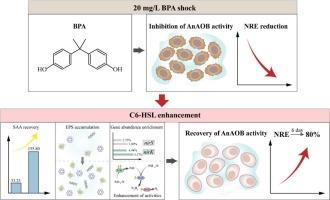外源AHLs对双酚a抑制厌氧氨氧化生物膜系统的快速恢复
IF 6.7
2区 工程技术
Q1 ENGINEERING, CHEMICAL
引用次数: 0
摘要
本研究通过外源信号分子的加入,探讨了双酚A (BPA)胁迫下厌氧氨氧化(anammox)生物膜系统快速恢复的可行性及其机制。采用两个厌氧氨氧化生物膜反应器,分别命名为R1(对照)和R2(外源C6-HSL)。经BPA长期冲击后,R2在6天内可达到80%以上的总无机氮去除效率,并保持稳定的性能,而R1需要12天才能达到相似的效率,且表现出运行不稳定性。R2处理的厌氧氨氧化活性提高了368.84%,显著优于R1处理的118.95%。R2关键酶活性超过初始水平,NIR、HZS和HZO分别达到0.96、1.79和3.19 U/g VSS。宏基因组分析显示,外源C6-HSL对厌氧氨氧化菌Candidatus Brocadia的相对丰度没有影响,但对nirS和nirK等功能基因的相对丰度有增强作用。其潜在机制与加速NO2—N向NO的转化有关,从而有效地加强厌氧氨氧化代谢途径。这些发现为群体感应在厌氧氨氧化生物膜系统处理含bpa废水中的作用提供了见解。本文章由计算机程序翻译,如有差异,请以英文原文为准。

Rapid recovery of bisphenol A-inhibited anammox biofilm systems by exogenous AHLs addition
This study investigated the feasibility and underlying mechanisms of rapidly recovering anaerobic ammonium oxidation (anammox) biofilm systems subjected to bisphenol A (BPA) stress through the addition of exogenous signal molecule. Two anammox biofilm reactors were employed, named R1 (control) and R2 (exogenous C6-HSL), respectively. After the long-term shock of BPA, R2 could achieve a total inorganic nitrogen removal efficiency more than 80 % within 6 days and maintained stable performance, whereas R1 required 12 days to reach a similar efficiency and exhibited operational instability. The specific anammox activity in R2 increased by 368.84 %, significantly outperforming the 118.95 % increase observed in R1. Furthermore, key enzyme activities in R2 exceeded their initial levels, with NIR, HZS, and HZO reaching 0.96, 1.79, and 3.19 U/g VSS, respectively. Metagenomic analysis revealed that exogenous C6-HSL would not influence the relative abundance of anammox bacteria, i.e., Candidatus Brocadia, while the relative abundance of functional genes, i.e., nirS and nirK, were enhanced. The underlying mechanism was associated with the accelerated conversion of NO2--N to NO, thereby effectively strengthening the anammox metabolic pathway. These findings provided insights into the role of quorum sensing in mediating anammox biofilm system performance in treating BPA-containing wastewater.
求助全文
通过发布文献求助,成功后即可免费获取论文全文。
去求助
来源期刊

Journal of water process engineering
Biochemistry, Genetics and Molecular Biology-Biotechnology
CiteScore
10.70
自引率
8.60%
发文量
846
审稿时长
24 days
期刊介绍:
The Journal of Water Process Engineering aims to publish refereed, high-quality research papers with significant novelty and impact in all areas of the engineering of water and wastewater processing . Papers on advanced and novel treatment processes and technologies are particularly welcome. The Journal considers papers in areas such as nanotechnology and biotechnology applications in water, novel oxidation and separation processes, membrane processes (except those for desalination) , catalytic processes for the removal of water contaminants, sustainable processes, water reuse and recycling, water use and wastewater minimization, integrated/hybrid technology, process modeling of water treatment and novel treatment processes. Submissions on the subject of adsorbents, including standard measurements of adsorption kinetics and equilibrium will only be considered if there is a genuine case for novelty and contribution, for example highly novel, sustainable adsorbents and their use: papers on activated carbon-type materials derived from natural matter, or surfactant-modified clays and related minerals, would not fulfil this criterion. The Journal particularly welcomes contributions involving environmentally, economically and socially sustainable technology for water treatment, including those which are energy-efficient, with minimal or no chemical consumption, and capable of water recycling and reuse that minimizes the direct disposal of wastewater to the aquatic environment. Papers that describe novel ideas for solving issues related to water quality and availability are also welcome, as are those that show the transfer of techniques from other disciplines. The Journal will consider papers dealing with processes for various water matrices including drinking water (except desalination), domestic, urban and industrial wastewaters, in addition to their residues. It is expected that the journal will be of particular relevance to chemical and process engineers working in the field. The Journal welcomes Full Text papers, Short Communications, State-of-the-Art Reviews and Letters to Editors and Case Studies
 求助内容:
求助内容: 应助结果提醒方式:
应助结果提醒方式:


